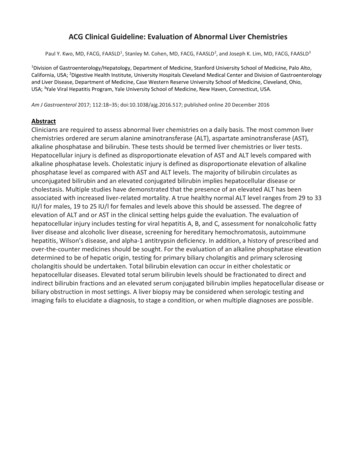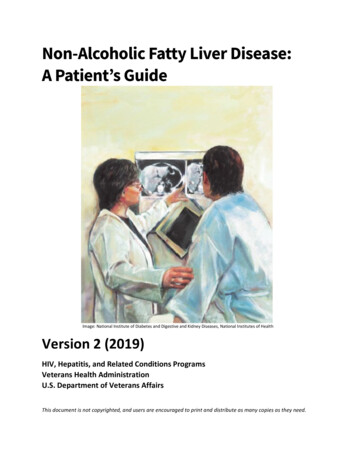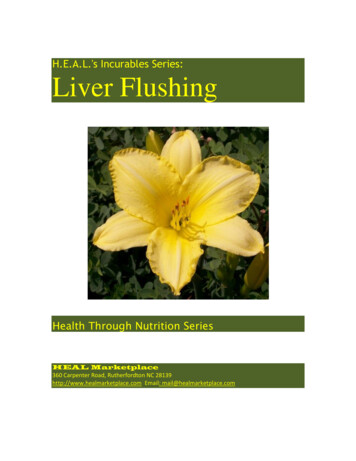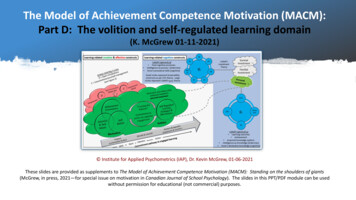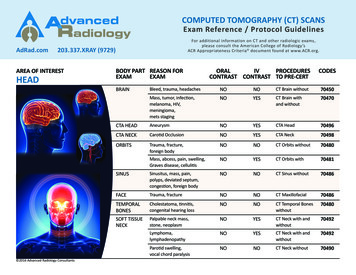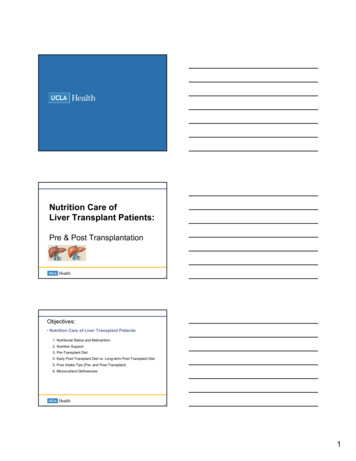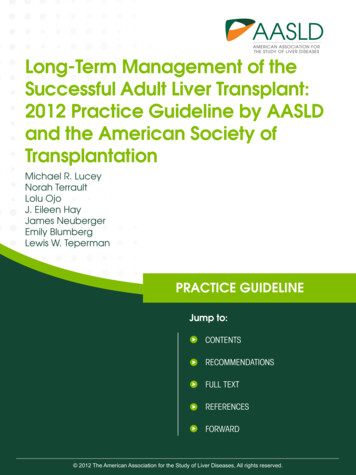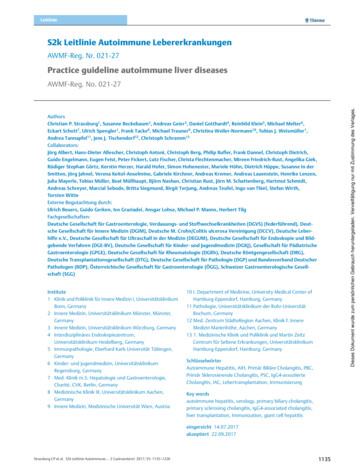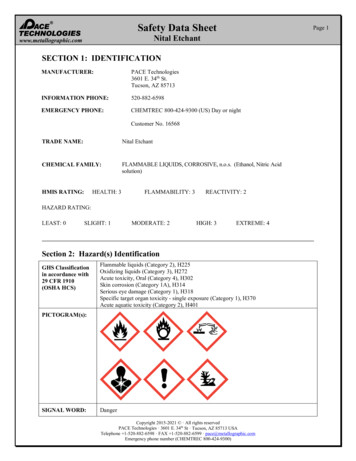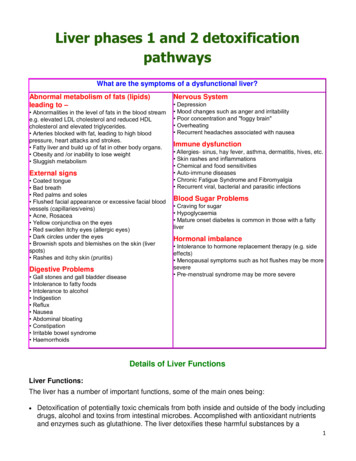
Transcription
Liver phases 1 and 2 detoxificationpathwaysWhat are the symptoms of a dysfunctional liver?Abnormal metabolism of fats (lipids)leading to – Abnormalities in the level of fats in the blood streame.g. elevated LDL cholesterol and reduced HDLcholesterol and elevated triglycerides. Arteries blocked with fat, leading to high bloodpressure, heart attacks and strokes. Fatty liver and build up of fat in other body organs. Obesity and /or inability to lose weight Sluggish metabolismExternal signs Coated tongue Bad breath Red palms and soles Flushed facial appearance or excessive facial bloodvessels (capillaries/veins) Acne, Rosacea Yellow conjunctiva on the eyes Red swollen itchy eyes (allergic eyes) Dark circles under the eyes Brownish spots and blemishes on the skin (liverspots) Rashes and itchy skin (pruritis)Digestive Problems Gall stones and gall bladder disease Intolerance to fatty foods Intolerance to alcohol Indigestion Reflux Nausea Abdominal bloating Constipation Irritable bowel syndrome HaemorrhoidsNervous System Depression Mood changes such as anger and irritability Poor concentration and "foggy brain" Overheating Recurrent headaches associated with nauseaImmune dysfunction Allergies- sinus, hay fever, asthma, dermatitis, hives, etc. Skin rashes and inflammations Chemical and food sensitivities Auto-immune diseases Chronic Fatigue Syndrome and Fibromyalgia Recurrent viral, bacterial and parasitic infectionsBlood Sugar Problems Craving for sugar Hypoglycaemia Mature onset diabetes is common in those with a fattyliverHormonal imbalance Intolerance to hormone replacement therapy (e.g. sideeffects) Menopausal symptoms such as hot flushes may be moresevere Pre-menstrual syndrome may be more severeDetails of Liver FunctionsLiver Functions:The liver has a number of important functions, some of the main ones being: Detoxification of potentially toxic chemicals from both inside and outside of the body includingdrugs, alcohol and toxins from intestinal microbes. Accomplished with antioxidant nutrientsand enzymes such as glutathione. The liver detoxifies these harmful substances by a1
complex series of chemical reactions. The role of these various enzyme activities in the liveris to convert fat soluble toxins into water soluble substances that can be excreted in theurine or the bile depending on the particular characteristics of the end product.Storage of sugar as 'glycogen' and regulation of blood sugar levels.Production and storage of proteins as well as the regulation of many substances involved inprotein metabolism.Production of bile which aids in the digestion of fats.Production of blood proteins, clotting factors and substances important to the production ofred blood cells (erythrocytes)Regulation of a number of hormones.Neutralization of 'free-radicals' by antioxidants. Free radicals are highly reactive oxygenmolecules that can damage tissues.Storage of vitamins, mainly iron, copper, B12, vitamins A, D, E and KIt plays an important role in digestion (breaking nutrients down)Involved with assimilation (building up body tissues).Red blood cells, which are responsible for carrying oxygen around the body, are recycled inthe liverMany factors determine whether the liver performs its critical functions well. Too much pressureon the liver from overeating rich or poor-quality food, environmental stresses, overwork oremotional stress can cause liver overload, leading to a decreased ability to clear toxins andhormones and manufacture bile. Foods which contain high levels of antioxidants help to protectthe liver and keep it healthy while other foods cleanse the liver.Click here to view the different steps of detoxification of a “healthy” or “unhealthy” liver.The symptoms of a sluggish or overtaxed liver are varied and can include excess weight, liverand gall bladder diseases, headaches and migraines, digestive problems, allergies, immunesystem problems such as hay fever and asthma, food and chemical sensitivities, constipation,unexplained fatigue, skin itching and irritation, PMS and other menstrual problems.Foods to Eat for Liver Health:There are certain foods that help to protect and detoxify the liver itself so that it can performbetter to detox the entire body: Apples contain pectin which helps to bind and excrete heavy metals right off theintestines. This directly helps to reduce the load of filtration on the liver.Beets, carrots, red onions and aubergine (eggplant) contain flavonoids and betacarotene which are potent antioxidants.Garlic contains allicin and the mineral selenium, both antioxidants. It assists the removalof heavy metals from the liver.Eggs, brown rice and whole grains, broccoli and spinach contain B-complex vitaminswhich improve liver function and promote liver decongestion.Vitamin B12 helps to metabolize fats and improves liver health.Cruciferous vegetables such as cauliflower, broccoli, cabbage, Brussels sprouts, BokChoy, kale, radishes, and turnips contain glucosinolates which help the liver produceenzymes for detoxification.Grapefruits are rich in antioxidants and help in natural detoxification of liver.2
Bitter vegetables such as bitter gourd, dandelion greens, mustard greens and chicorypromote the production and flow of bile.Tips for a healthy liver: Eat organically produced foods as much as possible to avoid toxic chemical residues.Avoid artificial flavorings and preservatives.Avoid damaged fats such as hydrogenated fats found in many processed foods.Use cold pressed oils and do not use them for cooking. Only a little butter, a saturated fat(coconut oil), should be used for cooking. Cooking with olive oil is still controversial. If usedthen do not heat it to a high temperature and add AFTER food has been removed from heat. Make sure your nuts and seeds are really fresh. Avoid excess saturated animal fat like sausage, bacon, salami, hot dogs, high fat dairyproducts like whole milk, ice cream and cheese. Alcohol is known to be a powerful toxin that will damage the liver.Treating your liver well by following the above advice will have a huge impact on your healthand longevity.Liver DetoxificationThe major percentage of blood being filtered by the liver is from the portal vein, which carriesblood from the intestines. The liver can remove a broad spectrum of microorganisms such asbacteria, fungi, viruses and parasites from the blood, which is desirable, as we certainly do notwant these building up in the blood and invading deeper parts of the body. Infections andparasites often come from the contaminated water supplies found in large cities, and indeedother dangerous organisms may find their way into your gut and blood stream from thesesources. This can cause chronic infections and poor health, so it is important to protect your3
liver from these microorganisms. The safest thing to do is drink water that has been filtered andsterilized. High loads of unhealthy microorganisms can also come from foods prepared inconditions of poor hygiene by persons who are carrying bacteria, viruses or parasites on theirskin. Foods, especially meats that are not fresh or are preserved, also contain a higher bacterialload, which will overwork the liver if they are eaten regularly.Many of the toxic chemicals that enter the body are fat-soluble, which means they dissolve onlyin fatty or oily solutions and not in water. This makes them difficult for the body to excrete. Fatsoluble chemicals have a high affinity for fat tissues and cell membranes, which are composedof fatty acids and proteins. In these fatty tissues of the body, toxins may be stored for years,being released during times of exercise, stress or fasting. During the release of these toxins,several symptoms such as headaches, poor memory, stomach pain, nausea, fatigue, dizzinessand palpitations can occur.General Liver Detoxification NutrientsFoods to aid detoxification: Beetroot and artichoke: helps with liver drainageBroccoli, cauliflower and other cruciferous vegetables: these aid cytochrome P450 activityProteinRadish, watercress: rich in sulphurAlbion family vegetables: garlic, onionsHigh fiber foods such as whole grains, psyllium, flax seeds, fruit and vegetables: fiber bindstoxins and eliminates them through the GI tract4
Supplements to aid liver detoxification: B-complex vitamins: necessary co-factors used in Phase 1 detoxificationDigestive enzymes: may be necessary to ensure that protein is adequately digested andglycine is readily availableEssential fatty acidsN-acetyl cysteine (NAC): an immediate precursor to glutathione, a potent antioxidant andamong the most import detoxification nutrients for the liverReduced glutathioneSelenium, zinc, magnesium and manganese; possibly iron and copper if used with cautionTaurine (a useful combination product is magnesium taurate)Vitamins C and E and beta carotene.Inositol & Methionine: lipotropic agents (help with the breakdown of fat in metabolism) thatwork to transport fat out of the liverHigh ORAC vegetable extract blend with polyphenols (a phytonutrient)Vitamins and minerals – particularly the B vitamins – play a major role, acting as co-factors formany enzyme systems including those of liver detoxification, therefore making sure youconsume enough of the B complex group of vitamins is of prime importance for optimumdetoxification. Including plenty of whole grains which contain B vitamins in the diet as well astaking a good B complex supplement will aid the liver in this crucial role.Depletion of vitamin C may also impair the detoxification process; vitamin C also prevents freeradical formation. Vitamin C is found in citrus fruits and green leafy vegetables. However, inorder to obtain optimum amounts supplementation is required. I recommend at least a fewgrams a day.Vitamin E and selenium are co-factors for glutathione peroxidase activity as well as beingpowerful antioxidants. (Vitamin E also works synergistically with vitamin C.) Today, our diets arevery low in selenium due to the depletion of the soil of this vital mineral. Supplementation istherefore important.Cruciferous vegetables such as broccoli, cauliflower, brussel sprouts and cabbage in the diethave been shown to enhance Phase I activities. I use those when vegetable juicing on afrequent basis.Zinc is another essential nutrient and acts as a co-factor for many enzyme systems. Zincdeficiency can cause a whole range of consequences. One important role that zinc plays is inthe functioning of an enzyme alcohol dehydrogenase involved in the conversion of alcohols toaldehydes in Phase I detoxification. Therefore anyone who drinks alcohol should ensure theyhave optimum amounts of zinc in their diet.Liver herbs to aid detoxification (traditionally known as 'blood cleansing' herbs): Dandelion root, beet leaf & Yellow Dock: cholagogue (stimulates liver secretions and bileflow) Artichoke leaf: promotes regeneration of the liver and promotes blood flow in that organ,stimulates bile flow5
Silymarin (bioflavonoid found in Milk Thistle): according to research, this herbal extractstabilizes the membranes of liver cells, preventing the entry of virus toxins and other toxiccompounds including drugs. Supports the protection of the liver and promotes it’sregeneration. Turmeric: a cholagogue like dandelion, but may irritate the gastric mucosa. Its advantagesare its cheapness and ability to be used in cookery.Note: These herbs are best combined with wild yam, which helps to prevent liver spasmscaused by gall bladder-stimulating herbs. (Also see Secondary plant metabolites.)Coffee Enema Helpful In Liver DetoxificationThe use of coffee in enemas for liver detoxification purposes is well known. It is a commonherbalogical remedy that has been suggested by holistic and alternative medicine professionalsfor many years.The coffee enema has been used for many years to detoxify the liver. It is a low-volume enemathat remains only in the sigmoid colon. There is a duct between the sigmoid colon and the livercalled the entero-hepatic circulation system. When the stool reaches this point, it contains manytoxins, which are sent to the liver for detoxification.Coffee Enema For Liver DetoxificationThe caffeine that is absorbed into the entero-hepatic system causes the liver ducts, includingthe bile ducts, to empty into the sigmoid colon and be eliminated. Releasing the toxins in theliver ducts, makes room for toxins from the body to enter the liver for detoxification. Thealkaloids in the caffeine stimulate the production of glutathione-S-transferase, which is anenzyme that facilitates the liver detoxification pathways. Coffee enemas will not waste mineralsand electrolytes because they have already been absorbed in the previous sections of theintestines. The coffee enema is safe even for people who are sensitive to caffeine because thecoffee remains in the sigmoid colon, where it will not be absorbed, provided the proper amountis used and the enema bag is not place too high.The liver phases in a nutshell6
Phase 1During the phase 1 pathway, toxin chemicals and metals (from food, water, and air) areconverted into less harmful chemicals through many chemicals reactions through the inductionof P-450 enzyme.Does even the smallest bit of caffeine keep you wide awake at night? You could have sluggishphase I detox. Can you guzzle two cups of coffee in the afternoon and sleep just fine? Yourphase I enzymes might be over active.Specially targeted nutrients can do wonders for your liver's detoxifying ability.Substances that activate or induce Phase 1 detoxificationNote: The term "induce" can be misleading as it refers to anything that fires up the system those that are harmful which need processing, and those which aren’t harmful and activateprocessing.Drugs and Environmental Toxins: acetate, alcohol, barbiturates, carbon tetrachloride, dioxin,exhaust fumes, nicotine in cigarette smoke, organophosphorus pesticides, paint fumes,pesticides,Phenobarbital, steroid hormones, sulphonamides (sulpha drugs)Bad Foods: charcoal-broiled meats, high protein diets, saturated fats,Good Foods: Indoles from cruciferous vegetables: cabbage, broccoli, and brussels sproutsDiets adequate in protein (meat, fish and eggs or vegetable protein)7
oranges and tangerines (but not grapefruits)Nutrients: Vitamins : Vitamin B1, Vitamin B2 (riboflavin), Vitamin B3 (niacin), Vitamin B6, Vitamin B9(Folic Acid), Vitamin B12, Vitamin C Lipotrophics – compounds that break down fat in metabolism (cysteine, methionine,choline, and inositol) Minerals: Magnesium & Iron Antioxidants: Glutathione, Flavonoids (such as catechins – found in green tea)Herbs: caraway, dill seeds, Milk Thistle, sassafras teaSubstances that Inhibit Phase 1 detoxificationNote: In general, inhibition of detoxification is not desired. In the case of Gilbert's Syndrome,there is an exception to Phase 1 inhibitors, as at a certain level it can allow Phase II detox tokeep up with it.Drugs: benzodiazepines; antihistamines; cimetidine and other stomach-acid secretion blockingdrugs; ketoconazole; sulfaphenazolePhytochemicals in Foods: naringenin from grapefruit juice; curcumin from turmeric; capsaicinform chili pepper; eugenol from clove oil; quercetin from onionsBotanicals: curcuma longa (curcumin); capsicum frutescens (capsaicin); eugenia caryophyllus(eugenol); calendula officianalisOther: aging; toxins from inappropriate bacteria in the intestinesPhase 2A diet low in protein-all too common in women who are trying to lose weight with a low-fat dietcan dramatically slow phase II detoxification. Aspirin and other non-steroidal anti-inflammatorydrugs (NSAIDs), including ibuprofen (found in Advil, Nuprin, and other products), also slowphase II detoxification.Does garlic make you sick? Does your urine have a strong smell after you eat asparagus? Didyou suffer from toxemia during your pregnancy? Any of these symptoms may indicate problemswith phase II.The phase 2 detoxification pathway is known as the conjugation pathway. This involvesconverting the fat-soluble toxic chemical and transforming the toxins into water-solublechemicals. Then they are passed out through body fluids as such as the bile or urine.For this 2nd pathway to function efficiently, there are some important substances needed toactivate the catalyst for toxin conversion.8
Note: There are various combination products available to support liver detoxification with anemphasis on one phase or both phases.Nutrients which encourage or activate Phase II include: Aspartic acidBlue green algaeBee pollenCruciferous vegetables (broccoli, cabbage, brussels sprouts, cauliflower)GlutamineGlutamic acidGlycineGrapefruit juice contains naringenin, a substance which slows down Phase 1 enzymeactivity. This increases the half life of some drugs, causing them to remain active longer.If you already have a sluggish Phase 1 and are on medication: Caution is advised whentaking large doses of grapefruit juice and some drugs.MolybdenumSulfur-containing amino acids like Cysteine (or NAC), Taurine or Methionine.Sulfur-containing amino acid foods: meat protein, eggsSulphur-containing phytonutrients available from garlic, shallots, onions, etc.Vitamin B12Note: The debate about eating meat to get the amino acids that are needed for other liverdetoxification routes goes on. Some authorities maintain that red meat is needed to detoxifychemicals but others say that the vegetarian diet with its complementary proteins such as rice(whole grains) with lentils or beans (legumes) will provide the same amino acids.After studying metabolic typing I have come to the conclusion that there is not one diet that isright for everyone. Some people do indeed need meat and will not thrive on a vegetarian diet.The 6 detoxification pathways of Phase 29
Click here to view a more detailed image than the picture below. (Note: There is a typo in thePhase 1 section - Riboflavin Vitamin B2 and NOT Vitamin A)1- The Sulphation (sulfation) pathway2- The Glucoronidation pathway3- The Glutathione conjugation pathway4- The Acetylation pathway5- The Amino Acid conjugation pathway (glycine, cysteine, glutamine, methionine, taurine,glutamic acid and aspartic acid)6- The Methylation (& Sulfoxidation) pathwayNutrients needed by phase II detoxification enzymesSulfation: Molybdenum, Cysteine and its precursor Methionine, co-factors (Vitamin B12, FolicAcid (B9), Methyl Donors, Magnesium, B-6/P-5-P), MSM, S-adenosyl-methionine (SAMe),TaurineGlucuronidation: Glucuronic acid, Magnesium, B-VitaminsGlutathione conjugation: Glutathione Precursors (Cysteine, Glycine, Glutamic Acid, and cofactors), Essential Fatty Acids (Black Currant Seed Oil, Flax Seed Oil, EPA), ParathyroidTissue, Vitamin B6Acetylation: Acetyl-CoA, Molybdenum, Iron, Niacinamide (B3), Vitamin B2Amino acid conjugation: Glycine (see Glycination) Glycination: Arginase Enzyme, Glycine, Gly Co-factors (Folic Acid, Manganese, B-2, B6/P-5-P)Methylation: Methionine, Co-factors (Magnesium, Folic Acid, B-12, Methyl Donors), Lipotropicnutrients (choline, methionine, betaine, folic acid, vitamin B12)Inducers of phase II detoxification enzymesSulfation: Food sources of: Cysteine, methionine, taurineGlucuronidation: Good: Fish oils, limonene-containing foods (citrus peel, dill weed oil, caraway oil) Bad: cigarette smoking, birth control pills, PhenobarbitalGlutathione conjugation: (Click here to read more about foods that increase Glutathione)10
Food: Asparagus, avocados, Brassica family foods (cabbage, broccoli, Brussels sprouts,kale, bok choy, watercress, mustard, horseradish, turnips, rutabagas, kohlrabi), limonenecontaining foods (citrus peel, dill weed oil, caraway oil), papaya, red beets, watermelonNote: Generally fresh fruits and vegetables contain from 25mg up to 750mg glutathione perpound so that is why we see so many detoxification diets recommending an abundance of thesefoods.Acetylation: Food sources of: Acetyl-CoA, Molybdenum, Iron, Niacinamide (B3), Vitamin B2Amino acid conjugation: Food sources of GlycineMethylation: Food sources of lipotropic nutrients (compounds that help to break down fat inmetabolism) - Ex: choline (found in Lecithin), methionine, betaine, folic acid (B9), vitamin B12Inhibitors of Phase II Detoxification EnzymesNote: Inhibition of phase II detoxification is not desired, especially in those with Gilbert'sSyndrome, as these enzymes are already inhibited.Sulfation: Non-steroidal anti-inflammatory drugs (e.g. aspirin), tartrazine (yellow food dye),molybdenum deficiencyGlucuronidation: Aspirin, probenecidGlutathione conjugation: Selenium deficiency, vitamin B2 deficiency, glutathione deficiency,zinc deficiencyNote: The drug Morphine depletes Glutathione levels. We also produce less Glutathione as weage.Acetylation: Vitamin B2, B5, or C deficiencyAmino acid conjugation: Low protein dietMethylation: Folic acid or vitamin B12 deficiencyThe liver phases in detailYour liver is your most important organ of detoxification and continuously processes all forms ofsubstances, from your digestive tract and the rest of your body, throughout the day. It has todeal with all these compounds, some of which are very toxic and others which are beneficial,and decide what to do with them. Your liver is very good at deciding what needs to be kept andwhat needs to be removed. It functions like a massive chemical plant that manufactures certaincompounds, detoxifies dangerous compounds, and directs substances all over the body for use,storage or excretion. Your liver makes use of two pathways in order to carry out its detoxificationwork – phase 1 and phase 2 pathways. You can think of phase 1 as being responsible forbreaking things down and then sending the raw materials to phase 2, which builds newsubstances from the raw material by adding molecules to them (this is called conjugation).11
You need to supply the ‘special conjugation substances’ via your diet or the productionlines come to a halt. If one conveyor belt stops because it is missing its ‘special substance’, theother conveyor belts are equipped to deal with some of these jammed items that needconjugation. But certain compounds are restricted to only go down a specific pathway andproduction must wait until more of the ‘special substance’ is provided. Even still, phase 1 doesnot stop production and it just keeps on going.Since many of these ‘special substances’ can be derived from big proteins that you eat, it showswhy regular protein meals are vital for ill people. Sometimes your body is unable to go throughall of the specific steps it needs to, in order to break complex proteins down fully and therebyprovide phase 2 some of the seven particular ‘special substances’. For example, sulphur (sulfurfoods) are metabolized down through several steps in order to produce sulphate (sulfate), butsome people are unable to complete the conversion of sulphur into sulphate, or they do itpoorly, due to faulty or poisoned enzymes. In order to keep the Sulphation pathway moving,they must supply sulphate to the body via supplements taken on a daily basis, such asMagnesium sulphate (Epsom Salts) or Glucosamine sulphate. Different people will havedifferent problems with different pathways.You can think of the toxic metabolites from phase 1 as many freshly laid and fragile eggs fromdifferent birds that are churned out every second in the phase 1 factory. These eggs need to bequickly organised and sent down the correct conveyor belt or they will back-up and create ahuge mess. Chicken eggs must go down the chicken egg conveyor belt, and geese eggs downthe geese egg conveyor belt. So the eggs are swiftly organized onto specific conveyor phase 2belts where workers (phase 2 enzymes) add certain ‘special substances’, to create boxes andbubble wrap (taurine, glycine,sulphate) which stabilizes them and makes them ready fortransport.In Multiple Chemical Sensitivity (MCS) the phase 1 birds are making way to many eggs, whilethe phase 2 workers are overwhelmed and can’t keep up with the packing. This creates abottle-neck at the beginning of the phase 2 conveyor belt and the eggs spill over and make ahuge mess. When this happens in the body, the toxic metabolites that are bottle-necked at thebeginning of phase 2 start to circulate and cause a lot of damage throughout the system. Sowhen a person with MCS encounters certain compounds like perfumes or paint that need to bedetoxified by the phase 2 system and it is not working, then they get a lot of symptoms. Theseindividuals need help to slow down phase 1 pathways, with phase 1 inhibitors suchas niacinamide (500-1000mg/day) or grapefruit juice (250ml 3-4 times per day) or oreganooil, this also kills intestinal yeast and dosages vary) and support/speed up phase 2 pathways(e.g. with substances like sulphate or methyl groups).Grapefruit juice and curcumin (in tumeric, though people with high plasma cysteine and sulfurproblems are cautioned by Andy Cutler, in Amalgam Illness, as curcumin raises plasmacysteine further ) are able to accomplish both of these tasks by slowing down phase 1 andspeeding up phase 2 simultaneously. Here is a chart that shows the substances metabolised inthe phase 1 pathways, and inducers and inhibitors of the specific enzymes.It takes quite a bit ofpersonal experimentation to find out where exactly in your liver pathways you are havingtrouble.Phase 1 & Phase 2 must be in balanceIn some people the detoxification pathways (Phases I and II) are out of balance. For example, ifPhase I is more active than Phase II, a build up of reactive intermediate metabolites can occur12
which in turn can lead to tissue damage and disease. These people are referred to as"Pathological Detoxifiers".Pathological detoxifiers can be identified as those individuals who are highly sensitive to fumes Ex: paints and perfumes, react adversely to various pharmaceutical drugs and may have areaction to drinking caffeine.There is now an extensive body of evidence indicating that diet plays a crucial role in modifyingthe body’s detoxification pathways. Even in allopathic medicine grapefruit juice is utilised fortransplant patients as grapefruit contains naringenin, a substance which slows down Phase Ienzyme activity.This enables such drugs as cyclosporin – which is given to prevent organ rejection – to stay inthe system for longer prior to the drug being detoxified. Pathological detoxifiers may also find ituseful to include grapefruit juice in their diet.Phase 1Phase 1 uses many, many enzymes to break substances down. This phase as the‘SUBTRACTION’ phase of metabolism, where the enzymes work to subtract molecules fromsubstances and break them up into smaller more useful units, just like the process of fooddigestion does so in the gut. Phase 1 is utterly dependent on these ENZYMES, whose speed ofmetabolism is in turn affected by things like genetics, exercise and the presence or absence ofcertain substances/supplements in the diet that can either speed them up (induce them) or slowthem down (inhibit them). After the enzymes have broken down some of the substances, somevery toxic end products (metabolites) remain and they must quickly be shunted to phase 2pathway in order to make them safer for the body to use. Heavy metals in particular can makethese enzymes dysfunctional.Phase 1 is carried out by the cytochrome P 450 enzyme system and consists of oxidation andreduction reactions. Various nutrients are required in order for the Phase I detoxification systemto be carried out efficiently. Cytochrome P450 reactions generate free radicals and this cancause secondary damage to cells. An adequate supply of key antioxidants is therefore essentialto prevent tissue damage. Reduced glutathione, superoxide dismutase and additional nutrientssuch as beta carotene, vitamin E, selenium and N-acetyl-cysteine (NAC) will act as antioxidants.Other nutrient co-factors required for cytochrome P450 reactions include riboflavin, niacin,magnesium, iron and certain phytonutrients such as indoles from cruciferous vegetables andquercetin have been shown to support Phase I of liver detoxification.Cytochrome P450 is induced by some toxins and by some foods and nutrients. Obviously, it isbeneficial to improve phase I detoxification in order to eliminate toxins as soon as possible. Thisis best accomplished by providing the needed nutrients and non-toxic stimulants while avoidingthose substances that are toxic. However, stimulation of phase 1 is contraindicated if thepatient's phase II systems are underactive.Drugs and environmental toxins activate P450 to combat their destructive effects, and in sodoing, not only use up compounds needed for this detoxification system but contributesignificantly to free radical formation and oxidative stress. Among foods, the brassica(cruciferous) family – Ex: cabbage, broccoli, and Brussels sprouts, contains chemical13
constituents that stimulate both phase 1 and phase 2 detoxification enzymes. One suchcompound is indole-3-carbinol, which is also a powerful anti-cancer chemical. It is a very activestimulant of detoxifying enzymes in the gut as well as the liver. The net result is significantprotection against several toxins, especially carcinogens. This helps to explain whyconsumption of cabbage family vegetables protects against cancer.Oranges and tangerines (as well as the seeds of caraway and dill) contain limonene, aphytochemical that has been found to prevent and even treat cancer in animal models.Limonene's protective effects are probably due to the fact that it is a strong inducer of bothphase I and phase II detoxification enzymes that neutralize carcinogens.The metabolites from this detoxification process are often potentially more harmful than theiroriginal toxic compounds and it is important for health that these toxic compounds do not buildup. This is where Phase II of liver detoxification comes in.I
Abnormal metabolism of fats (lipids) leading to – Abnormalities in the level of fats in the blood stream e.g. elevated LDL cholesterol and reduced HDL cholesterol and elevated triglycerides. Arteries blocked with fat, leading to high blood pressure, heart attacks and strokes
